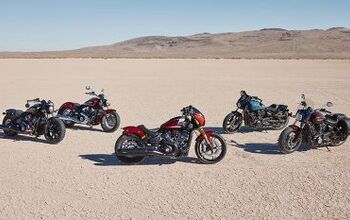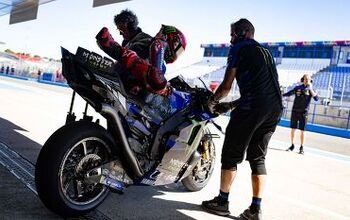Church of MO: 2001 Suzuki Bandit 1200S
In March, 2001, little did we know our pleasant little applecart was about to be rudely upset. That’s right, the www was gaining traction and MO was becoming a going concern. Six months later came the little matter of 911, which upended how we lived, or didn’t anymore, and set the world on fire – literally at first and figuratively later. Of all the air-cooled motorcycles we loved before, when ignorance was bliss and global warming was still theoretical, the big Suzuki Bandit 1200 might be the one we still miss the most. A reading from the Book of Minime and Calvin, photos by the apostle Tom of Velvia.
Just Another UJM?
Los Angeles, July 18, 2000 — A normal part of any new bike intro is a photo session somewhere around the mid to late portion of the day’s ride. This particular intro saw Tom Riles behind the lens, pointing away at various riders taking their turns through bends in the road until, in one particularly off-camber and nasty corner, Master Riles got the living stuff scared out of him when we came towards him at a high rate of speed sounding like we were towing an anvil along behind us; complete with sparking light show and a little bob-and-weave of the chassis to add just a little more drama to the moment.No worry, Tom, we’re professionals; and that’s just the foot pegs carving a little niche for themselves in the pavement while the front end sticks to the road and the Macadam 90X tires let us know pretty much everything but the half-life of the pebbles they’re coming in contact with. Granted, this is no racebike – or even a real sport bike when you get down to it – but for a semi-faired standard, it does a remarkable impression from time to time, given a bit of impetus from, lets say, a photographer in close proximity with a loaded camera pointed your way?What’s so impressive about this Bandit compared to previous iterations is not so much what it does well, as much as what it doesn’t do:
The mirrors don’t turn your rearward view into something that resembles a kaleidescope at anything above idle; the minimalist-looking fairing doesn’t buffet your helmet until the paint job starts flaking off; the motor doesn’t buzz your hands to the point that you’re willing to clamp them in a vice just to see if there’s a chance of ever recovering some feeling in them; and the front end doesn’t turn to junk after 600 miles of fun – which is what this bike delivers far more frequently and in much greater quantity than you’d ever suspect.When we sampled Suzuki’s Bandit 600S a few months ago we were please with the bike, but not overly impressed. It was a good commuter and could pull off mild sport duty pretty well, but the motor was a bit on the wheezy side and, paired with an obnoxious buzz, not all that fun to do the highway drone on should there be ample mileage between your chosen set of curves. We expected similar things from the 1200 but, once again Suzuki has surprised us with a bike that is, pardon the cliche, more than the sum of its parts.
Bandit 1200 sales started off at a rather lowly 18,160 units in 1996 only to surpass the 60,000 mark for 1999 which is a three-fold increase in only three years, but Suzuki doesn’t plan on stopping there. Having done extensive market research, they found that the average Bandit buyer is 35 to 44 years of age, has over 15 years of riding experience and uses the bike as a secondary vehicle primarily for sport touring duty which goes a long way towards explaining the focus of the Bandit’s changes. At a retail price of $7,399 (an increase of only $150 US Dollars), it’s no surprise that 87 percent of buyers say their number one reason for choosing the Bandit is value. But, thankfully, a neutered price tag does not come at the expense of diminished fun.
The design goal for the new Bandit was to, “maintain the Bandit’s originality and distinctive character while refining performance and features.” There was a paradox created in the execution of these parameters in that the design team wanted not only sportier performance, but a comfortable ride as well; the two of which rarely, if ever, go hand in hand.
“Yeah, baaaby. This bike is all about me. I am this bike on so many levels it’s scary.”
Suzuki hopes that they addressed most of the complaints from earlier models with this Year 2001 Bandit 1200S, starting with the larger fuel tank capacity. The new model carries 20 liters which is a one liter increase over the previous model. While this is definitely a good thing in the long run, a few of us on the intro noted a slightly more top-heavy feel to the (fully fueled) bike when compared – seat of the pants – to the previous version. As for the other improvements, there were fewer side-effects than with the larger gas tank.
The main targets with the motor were to improve what was not only sluggish throttle response, but carburetion that was excessively lean and was sometimes surge-happy when cruising along at certain RPM. Along the way, Suzuki felt it wise to empower the old mill with a few more foot-pounds of torque as well as some more horsepower at low and mid-range speeds, and who are we to argue with a notion like that?
Again, a caveat in that Suzuki – while addressing the lean surging – would attempt to clean up emissions even further, seemingly leading to even worse surging. But Suzuki was able to attain their lower emissions goal while not only eliminating most – if not all – of the surging and what was previously a rather wicked flat spot in the power with the help a new throttle position sensor (TPS) on the Mikuni BSR36 carburetors. Mated with ignition timing maps which are different not only from the previous year’s version, but from each other as well. The number two and three cylinders and the number one and four cylinders have different maps that vary dependent upon throttle opening as well as engine RPM.
Even more power was found by changing the cam profiles and a few changes were made to stand up to the added oomph as well as to ensure longevity. The new oil cooler has grown from 280 mm tall to 355 mm tall while maintaining the same width which should allow the engine to make incrementally more power and last a bit longer. There’s also a clutch release cylinder which grew from 35.7 mm in diameter to 38.1 mm that, coupled with stronger clutch springs should make for a clutch assembly that will be able to stand up to a few aftermarket add-ons without much in the way of fanfare. Only a few whiny people commented on a perceived increase in the force required to pull in the clutch lever. But they’re weak and you’re not. Right? Aaargh.Adopting a similar system to that of Yamaha’s Air Induction System (AIS), Suzuki has been fitting its Pulsed Secondary Air Injection System (PAIR) to California-bound Bandits, Hayabusas and GSX-Rs, that will now be standard issue on all Bandits in all markets. The PAIR system does not effect power output but it does add a few extra pounds to a machine which could already stand to lose a few pounds.
In Suzuki’s efforts to endow the latest Bandit with “better stability and cornering performance,” a few key dimensions have been tweaked. Unfortunately, American Suzuki doesn’t have all the details as to what has been changed with the chassis so we can only give you a glimpse into what is the catalyst for a noteworthy increase in sporting performance. The wheelbase has been shortened by five millimeters and now measures 1,430 mm, helped by the reduction in trail by three millimeters to 104 mm. To quicken steering the caster has been decreased by 0.2 degrees, and to help keep rider weight and overall mass lower to the tarmac, the seat height was reduced by 45 mm to 790 mm. This seat provides not only wonderful support for burning through consecutive tanks of gas, but also enough firmness to allow mobility when shifting body weight in the twisties. Unfortunately, the seat cover looks like something off of a mid-eighties Volvo station wagon; but it goes well with the metallic silver paint on our bike whose enormous glitter flakes remind us of this girl who dances at this seedy little joint down the road from our offices.
All we know about the changes to the front suspension so far is that it received fork tube guards. As for the rear, there’s now a movable gas/oil separator in the shock. The front end features only pre-load adjustment while the rear features pre-load as well as rebound adjustment. Though that doesn’t seem like anything substantial, the new Bandit feels surprisingly planted on twisty roads when you chose to elevate the speeds to the point that the footpegs start dragging just before picking up the throttle and whooshing out of the apex of a turn. The cornering clearance is ample as long as you ride the bike like a sport-tourer even though, with a good rider aboard, El Bandito can catch a far sportier bike with its newfound cornering prowess and strengthened motor which is about as smooth as any inline motor of this size has a right to be. Above 85 mph this thing is turbine smooth and makes triple-digit cruising law-breakingly simple.
More by John Burns

































Comments
Join the conversation
"when ignorance was bliss and global warming was still theoretical"
You just can't help yourself, can you?
Baptist missionaries are less tiresome.
Great bike. Love the '96 personally.
https://uploads.disquscdn.c...